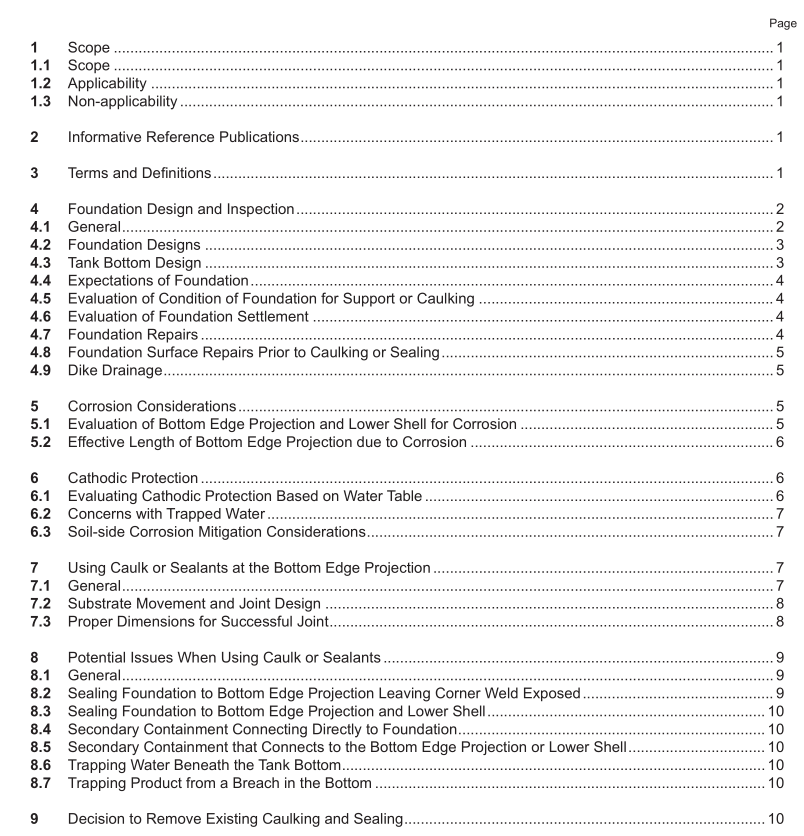API TR 654 pdf download

API TR 654 pdf download Aboveground Storage Tank Caulking or Sealing the Bottom Edge Projection to the Foundation
4.2 Foundation Designs
4.2.1 Full Concrete Pad In some instances, especially with smaller tanks, the tank may be resting on a reinforced concrete pad that ex- tends completely beneath the tank. If the concrete is structurally sound and there are no cracks, it is conceivable that there is little possibility of groundwater entering the area beneath the tank bottom from the underside. If surface water from rainfall can accumulate in the tank dike at levels above the bottom and there is a risk of water entering the gap between the tank and full concrete foundation, caulk or sealant may be of value and should be considered.
4.2.2 Ring Wall Foundation The greatest load to the ground is found beneath the shell at the perimeter of the tank. In designing a concrete ring wall foundation, the intent is to provide uniform, structurally sound support to the perimeter of the tank shell. The intent of the concrete ring wall is to minimize or prevent edge settlement, which can occur over time. The foundation may settle uniformly or may settle in an uneven fashion. When the foundation settles unevenly, the potential exists for gaps between the foundation and the bottom. Depending on the size of the gap, there is the possibility of selective edge settlement causing stress in the corner weld, as well as the possibility for water to intrude beneath the tank bottom from the containment dike.
4.2.3 Directly on Earthen Materials In cases where the tank bottom rests directly on a non-concrete surface, such as soil or other granular material, caulking or sealing is not possible and is not within the scope of this document. API Standard 650, Section 5.4.5, offers guidance for new tanks, but owner/operators can incorporate some of the new tank details on existing tanks. Some European designs are also available, including rain hoods and angle irons.
4.2.4 Double Steel Bottom With many jurisdictions requiring double tank bottoms without any uniform detail with respect to secondary con- tainment, many different confgurations and designs are being implemented. The installation of a double bottom creates the false shell, which is the portion of the shell that rests on the foundation. The loads through the false shell are different from those where the shell containing the product rests directly on the foundation. It is import- ant in the design that accumulating water not be allowed to enter the space between the existing bottom and the new bottom. Caulks and sealants may be part of the initial double bottom design; however, they will require inspection and maintenance. Often, caulks and sealants are specifed without detailed design or installation pro- cedures, and this should be avoided as it can result in ineffective protection of the interstice. The gap between the lower side of the upper annular plate and the false shell should be sealed to prevent water ingress into the interstitial space between the two bottoms. Welding this gap provides a permanent seal, although welding is not always a practical option. If caulks and sealants are used after a double bottom is installed, owner/operators should follow manufacturer’s instructions and good industry practice for joint details as outlined in Section 7.
4.2.5 Impervious Lining Material (Secondary Containment Non-steel Dikes) Many jurisdictions require secondary containment to be continuous across a tank dike. Attention to perimeter de- tails is critical to a good design. The requirement to have continuous containment and the design of the connec- tion to the foundation and/or tank will affect the choices for the caulking and sealing of the bottom edge projection to the foundation. Inspection and corrosion concerns should be addressed by the design.
4.3 Tank Bottom Design Tank bottom design can have a major impact on the need and effectiveness of caulking and sealing. Tank bot- toms can be oriented on a level plane, cone up, cone down (with or without drain dry piping), or uniformly sloped. If the intent of caulking is to keep water away from a cone-up bottom, it would be far better to allow any water that accumulates (either from condensing moisture or water table) to be able to easily drain from the perimeter.









